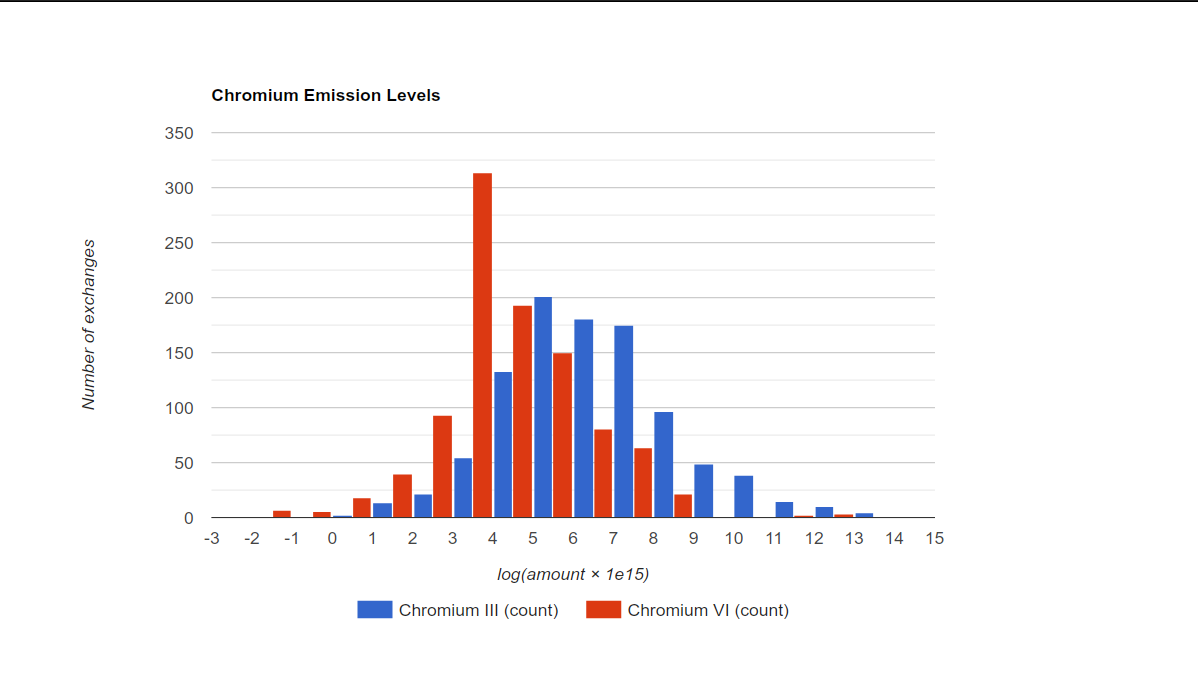Display a diagram with HTML
The following example shows how to display data in a diagram using HTML. In the example, all output
amounts of Emission to air/unspecified/Chromium III and Emission to air/unspecified/Chromium VI
are collected from a database, transformed with f(x) = log10(x * 1e15) to make a nice
distribution, and shown in a histogram using the
Google Chart API. An HTML
page is generated that is loaded in a SWT Browser in a separate window.
Retrieving the flow
The flows Chromium x are retrieved from the database by iterating over all flows named
Chromium x and then iterating over the categories of the flow.
To get all the flows name Chromium x, we use the FlowDao class. DAO stands for Data Access
Object, it is a class that provides access to the database without running complex SQL queries.
Every entities of openLCA has a category attribute that is a reference to the parent category. A
category can also have a parent category. In this example, we use the category hierarchy to filter
the flows. For each chromium name (Chromium VI, Chromium III), the following code is run:
def get_flow(name): # type: (str) -> Flow
"""
Get the flow `Emission to air / unspecified / Chromium ...` from the
database.
"""
flows = FlowDao(db).getForName(name)
for flow in flows:
c = flow.category
if c is None or c.name != "unspecified":
continue
c = c.category
if c is None or c.name != "Emission to air":
continue
return flow
Collecting the results
The amount of the output exchange of every process is collected from the database by running a SQL
query. The query is run using the NativeSql class, which is a wrapper around the database
connection.
def collect_amounts(flow): # type: (Flow) -> List[float or str]
results = [flow.name]
def collect_results(record):
results.append(math.log10(record.getDouble(1) * 1e15))
return True
print("Collecting results for {name}".format(**{"name": flow.name}))
query = (
"SELECT resulting_amount_value FROM tbl_exchanges WHERE f_flow = %i AND is_input = 0"
% flow.id
)
NativeSql.on(db).query(query, collect_results)
print("{size} results collected".format(**{"size": len(results) - 1}))
return results
Generating the HTML page
The HTML page is generated by injecting the results into a template.
Then, in order to display the page in a shell, we use the SWT Browser class. Yes! You can display
HTML pages in openLCA!
def make_html(results): # type: (List[List[float or str]]) -> str
"""Generate the HTML page for the data."""
html = """<html>
<head>
<script type="text/javascript" src="https://www.gstatic.com/charts/loader.js"></script>
<script type="text/javascript">
google.charts.load("current", {packages:["corechart"]});
google.charts.setOnLoadCallback(drawChart);
function drawChart() {
var data = google.visualization.arrayToDataTable(%s);
var options = {
title: 'Chromium Emission Levels',
legend: { position: 'bottom' },
hAxis: {
title: 'log(amount × 1e15)',
ticks: [%s]
},
vAxis: {
title: 'Number of exchanges'
}
};
var chart = new google.visualization.Histogram(
document.getElementById('chart_div')
);
chart.draw(data, options);
}
</script>
</head>
<body>
<div id="chart_div" style="width: 900px; height: 500px;"></div>
</body>
</html>
""" % (
json.dumps(results),
", ".join(str(x) for x in range(-3, 16)),
)
return html
Finally, the HTML page is loaded in a SWT Browser:
shell = Shell(Display.getDefault())
# set the window title
shell.setText("Chromium VI")
shell.setLayout(FillLayout())
browser = Browser(shell, SWT.NONE)
browser.setText(html)
shell.open()
To see the result, copy and paste the full script in the openLCA Python console in an opened ecoinvent database.
With ecoinvent 3.10.1 (APOS), the result looks like this:
